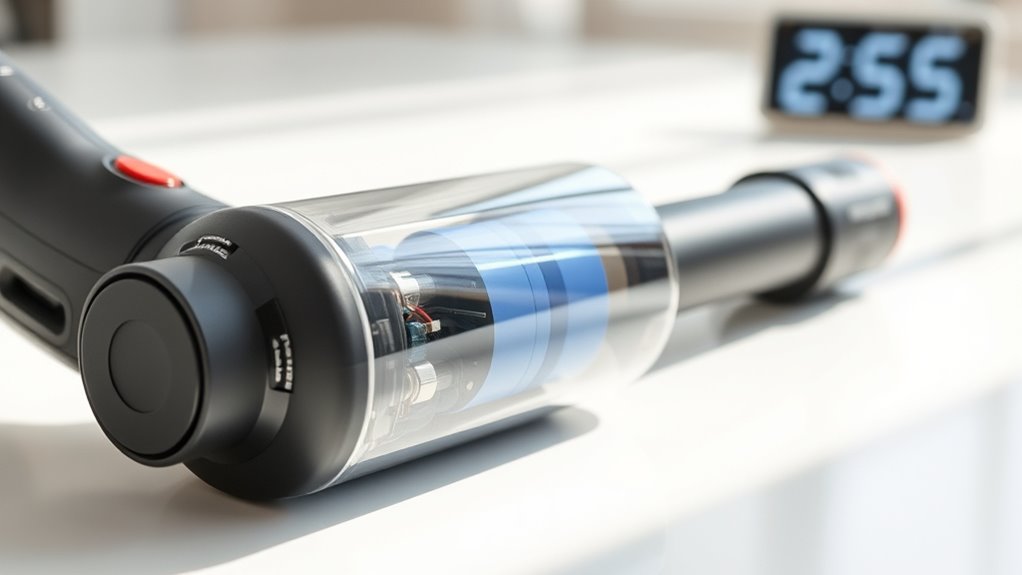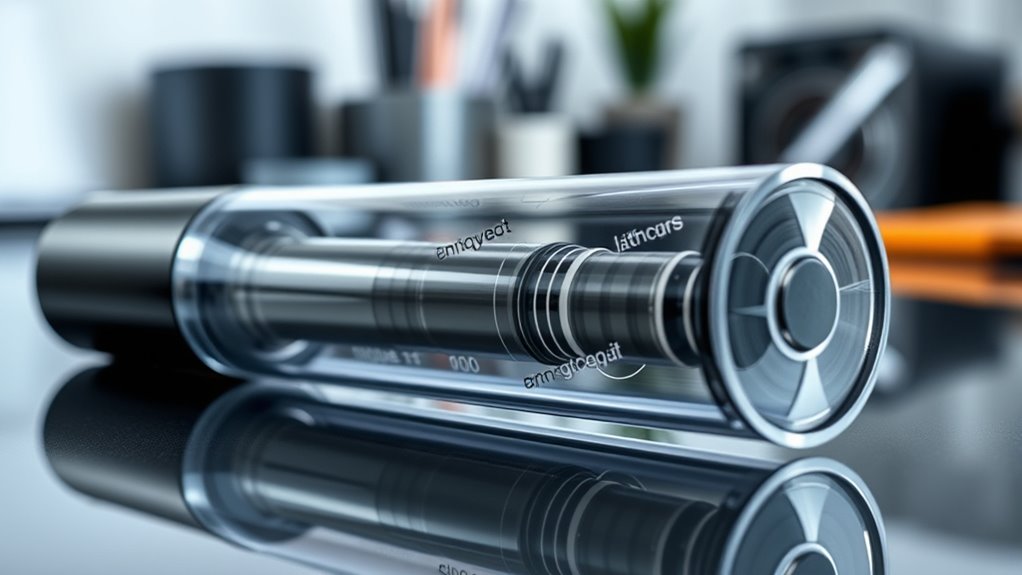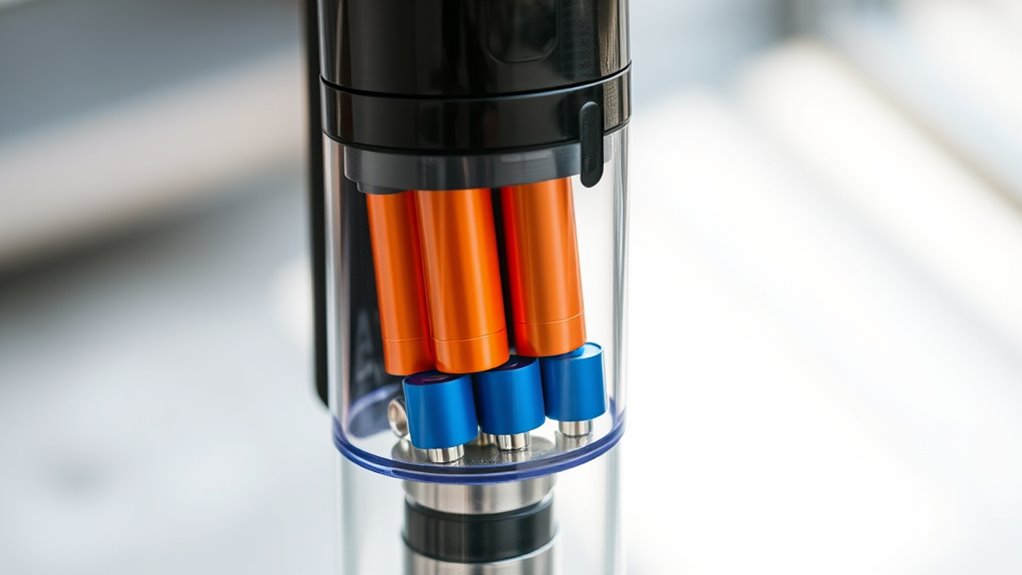Your stick vacuum’s battery life mainly depends on the battery chemistry, capacity, and how you use and care for it. Lithium-ion batteries provide the best balance of energy, safety, and durability, but their lifespan also relies on proper charging habits and avoiding overheating. Using the right charger and keeping the battery between 20%-80% charge helps it last longer. To discover more simple ways to boost your vacuum’s performance, keep exploring the key factors that impact battery health.
Key Takeaways
- Battery chemistry, especially lithium-ion, determines energy density, stability, and lifespan, directly affecting vacuum battery life.
- Proper charging habits and avoiding extreme heat prevent battery degradation and extend overall battery health.
- Higher capacity and voltage improve run time but require balanced design to prevent overheating and performance issues.
- Effective heat management during use and storage reduces thermal degradation, prolonging battery longevity.
- Regular maintenance, like cleaning contacts and using original chargers, ensures optimal performance and longer battery life.
Understanding Battery Chemistry and Types

Understanding the chemistry and types of batteries used in stick vacuums is essential for grasping how they perform and last. Battery manufacturing involves selecting specific chemistries, such as lithium-ion or nickel-metal hydride, which influence overall performance. Lithium-ion batteries are popular because they offer high energy density and longer lifespan, thanks to their chemical stability. Chemical stability guarantees the battery can handle repeated charge cycles without degrading quickly, maintaining consistent power output. Different chemistries also affect charging speed and safety. Knowing the battery’s chemistry helps you understand its durability, potential for overheating, and how it responds to daily use. In short, the choice of battery chemistry impacts your vacuum’s efficiency and longevity, making it a key factor in overall performance. HEPA Filtration technology in some models also contributes to cleaner air, enhancing the overall cleaning experience.
How Battery Capacity Affects Run Time

The capacity of a vacuum’s battery directly determines how long you can clean before needing to recharge. Battery capacity, measured in milliamp-hours (mAh) or watt-hours (Wh), reflects how much energy the battery can store. Higher capacity batteries provide longer run times, meaning you can clean more area without interruption. Voltage ratings, usually between 10.8V and 25.2V, also influence performance; higher voltage often indicates more power, which can improve efficiency but may drain the battery faster if capacity isn’t sufficient. Ultimately, a battery with greater capacity and appropriate voltage ratings allows you to maximize cleaning sessions. Understanding these factors helps you choose a vacuum with the right balance between power and run time, ensuring your cleaning remains uninterrupted. Additionally, battery technology advancements contribute to longer-lasting and more efficient vacuum batteries.
The Role of Battery Design and Quality

Battery design and quality considerably influence your vacuum’s performance and longevity. Higher-quality batteries are built with better materials, ensuring safer operation and durability. Manufacturers adhering to strict manufacturing standards prioritize battery safety, reducing risks like overheating or leaks. A well-designed battery features efficient cell arrangement and advanced cooling systems, preventing damage during use. When quality is compromised, your vacuum may run shorter or fail prematurely. Pay attention to the battery’s construction, certifications, and brand reputation to guarantee reliable performance. Here’s a quick overview:
| Aspect | Impact | Importance |
|---|---|---|
| Cell Material | Affects safety and lifespan | High-quality materials matter |
| Manufacturing Standards | Ensures safety and consistency | Prevents defects |
| Cooling System | Maintains performance and safety | Extends battery life |
| Design Efficiency | Influences run time and safety | Better design equals longer use |
| Certification | Validates safety and quality | Look for trusted labels |
Additionally, selecting batteries with proper certifications can further ensure you’re choosing a safe and reliable product.
Impact of Usage Habits and Charging Practices

Your charging habits and how often you use your vacuum can considerably affect its battery life. Using proper charging techniques prevents unnecessary wear, while frequent use can drain the battery faster. Knowing how these factors influence performance helps you get the most out of your vacuum’s battery. Additionally, understanding the battery technology involved can guide you in adopting best practices for maintenance and longevity.
Proper Charging Techniques
Proper charging habits can substantially extend the lifespan of your stick vacuum’s battery. To do this, always follow charging safety guidelines, such as using the charger provided by the manufacturer and avoiding overcharging. Keep your battery within recommended charge levels—preferably between 20% and 80%—to prevent unnecessary wear. Avoid leaving the vacuum plugged in for long periods, which can degrade the battery and void your battery warranty. Consistent, correct charging practices help maintain ideal performance and preserve warranty coverage. Additionally, understanding how automation technology impacts device longevity can inform better maintenance routines.
Usage Frequency Effects
How often you use your stick vacuum considerably impacts the battery’s lifespan. Frequent use means more power cycling, which accelerates battery degradation over time. Every time you turn it on and off, the battery undergoes power cycling, and repeated cycles wear it down faster. If you run your vacuum daily, you’ll notice the battery holding less charge as its capacity diminishes. To minimize this, avoid unnecessary use or try to complete cleaning tasks in fewer sessions. Proper charging practices, like not leaving the battery at 0% or 100% for extended periods, also help reduce battery degradation. Maintaining optimal battery health through proper usage habits can significantly extend the lifespan of your vacuum’s battery. By managing how often and how you use your vacuum, you can extend its battery life and maintain ideal performance longer.
Common Factors That Decrease Battery Longevity

Frequent charging cycles can wear out your vacuum’s battery faster than you might expect. Additionally, operating the vacuum at high temperatures can cause long-term damage to the battery’s health. Being mindful of these factors helps you extend your battery’s lifespan and maintain peak performance. To further preserve battery life, understanding battery safety measures and how AI-driven diagnostics can monitor battery health may prove beneficial.
Excessive Charging Cycles
Excessive charging cycles substantially shorten the lifespan of your stick vacuum’s battery. Each time you charge it, the battery undergoes a charging cycle, which accelerates battery aging. Repeated full charges can wear down the battery’s capacity faster, leading to decreased runtime over time. Avoid frequently charging from very low to full, as this stresses the battery and reduces its longevity. Instead, try to keep your charging cycles moderate to extend overall battery life.
Here are key points to consider:
- Frequent full charges accelerate battery aging.
- Partial charging helps preserve battery health.
- Overcharging or unnecessary charging adds to cycle count and shortens lifespan.
High Operating Temperatures
High operating temperatures can substantially reduce your stick vacuum’s battery lifespan, especially if you use or store it in hot environments. Excess heat accelerates thermal degradation, damaging the battery’s internal components. When heat isn’t properly dissipated, it builds up, causing stress on the cells and shortening their overall life. To understand this better, consider the following factors:
| Factor | Effect | Solution |
|---|---|---|
| Poor heat dissipation | Increases internal temperature | Use in cool environments or store properly |
| Extended exposure | Accelerates thermal degradation | Avoid leaving the vacuum in the sun |
| Overuse in heat | Reduces battery capacity | Allow cooling periods during use |
Proper heat management helps preserve your battery’s health, ensuring longer-lasting power. Additionally, understanding how thermal management influences battery performance can help prevent premature failure.
Tips to Maximize Your Vacuum’s Battery Life

To get the most out of your stick vacuum’s battery, it’s essential to use it wisely and maintain it properly. Properly caring for your battery extends its lifespan and improves performance. Always use designated charging stations to avoid overcharging or damaging the battery. When the battery is depleted, unplug it promptly to prevent unnecessary wear. Additionally, consider battery recycling options when your vacuum’s battery reaches the end of its life, instead of disposal. Regularly clean the charging contacts to ensure efficient charging. By following these tips, you can maximize your vacuum’s battery life and guarantee ideal cleaning performance. Understanding industry trends can also help you stay informed about new developments in battery technology.
Frequently Asked Questions
How Often Should I Replace My Vacuum’s Battery for Optimal Performance?
You should replace your vacuum’s battery every 1-2 years for peak performance. Regular battery maintenance, like avoiding deep discharges and keeping it charged within recommended levels, helps extend its lifespan. Keep an eye on charging cycles—if your vacuum’s runtime decreases markedly or it won’t hold a charge, it’s time to think about a replacement. Doing so guarantees your vacuum remains powerful and efficient during cleaning sessions.
Does Vacuum Usage Frequency Impact Battery Lifespan Significantly?
Your vacuum’s usage frequency definitely impacts its battery lifespan. Think of the battery chemistry as a delicate dance, where each charging cycle wears it slightly more. If you use your vacuum daily, you’ll hit more charging cycles, gradually reducing its capacity. To keep it performing well longer, avoid overcharging and let the battery rest between uses. Proper care guarantees you get the most out of each charging cycle, extending its lifespan.
Are There Specific Cleaning Modes That Drain the Battery Faster?
Yes, certain cleaning modes increase power consumption and drain your battery faster. High-suction or boost modes are designed for tough messes, but they require more energy, reducing your vacuum’s runtime. Standard or Eco modes use less power, helping your battery last longer. To maximize your vacuum’s battery life, switch to lower power settings when cleaning lighter messes, and reserve boost modes for heavy-duty tasks.
Can External Factors Like Temperature Affect Battery Performance?
Yes, external factors like temperature can affect your vacuum’s battery performance. Temperature effects are significant; extreme cold can reduce battery capacity and cause it to drain faster, while excessive heat may damage the battery over time. Environmental conditions influence how well your vacuum operates, so it’s best to store and use it within the recommended temperature range. Keeping your vacuum in moderate conditions helps maintain peak battery performance and prolongs its lifespan.
What Are Signs That My Vacuum’s Battery Is Nearing Failure?
If your vacuum’s battery is about to give out, you’ll notice it struggles to hold a charge—like it’s exhausted from a marathon. Power indicators might flicker or stay low, even after a full charge. Battery degradation causes shorter run times and inconsistent performance. If your vacuum suddenly needs frequent recharges or loses suction quickly, it’s a clear sign your battery’s nearing failure. Time for a replacement before it stops working altogether.
Conclusion
Think of your vacuum’s battery as a delicate seed—nurture it with mindful habits and quality care. Just like a seed needs the right environment to grow strong, your battery thrives with proper charging and usage. With patience and attention, you’ll preserve its significance, ensuring it continues to serve as the steadfast root of your cleaning routine. Respect its fragility, and it’ll reward you with lasting power, silently anchoring your home’s freshness.









